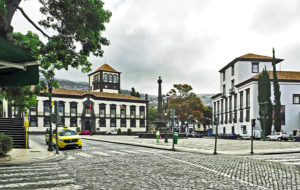On the south coast overlooking the Atlantic Ocean, Funchal is the capital of Madeira and surrounded by mountains rising to over 3000’ which catch the cloud. The area is dissected by deep ravines. Houses with their orange pantile roofs climb up the slopes. This is a city to be explored on foot and its compact size makes this possible (as long as you don’t mind the hills!) There are lots of bright yellow taxis around for those not wanting to walk. It also has a good bus service as well as three different HOHO routes (although I never did entirely work out where and when they all went.)
The area was settled from 1429 by João Gonçalves Zarco and his family. His statue stands proud on Avenida Arriaga in the centre of Funchal.
With its rich fertile soils and good port, the settlement grew rapidly as merchant families settled here. It was given city status at the start of the C16th and the cathedral was built. It was a frequent stop for vessels trading between Europe and the New World.
It’s increasing wealth and prosperity attracted pirate attacks. Many houses were built with watch towers allowing their owners to monitor shipping in and out of the port.
Forts were built to protect the harbour and along the sea front. The Palacio de Sao Lourenco is a massive white and black building on Avenida do Mar which was built in the C16th. It was the first fortress to be built and was also palace for the Governor. It is the most imposing example of civil and military architecture on the island. Today the west wing it is the official residence of the Representative of the Republic for the Autonomous Region of Madeira.
The city developed along the waterfront. The Old Town is centred round Rua de Santa Maria with its narrow cobbled streets. The area had got run down but is now being regenerated as a tourist attraction. Doorways have been painted as part of a public art exhibition. Eateries spilling out onto the pavement and jostling for attention. Staff stand outside exhorting visitors to stop and eat.
Streets in the town centre are wider and lined with trees. Pavements are made from small pieces of black basalt and white limestone arranged in decorative patterns. Away from the town centre, streets are narrower and lined with tall houses.
There are many impressive buildings dating from the C17th characterised by white walls with dark basalt window frames doors and corner stones. This style of architecture known as Mannerism is also seen in the churches where the stark black and white exterior contrasts with the exuberant baroque interiors with gilt paint and azulejo tiles. If you only visit one, make it “Igreja do Colegio,”:http://wasleys.org.uk/eleanor/otherholidays/madeira/funchal/churches/colegio/index.html the Jesuit College Church on Municipal Square.
Everywhere is very clean. There is no graffiti or litter. Street art is popular and there are statues and artwork scattered around the city.
Funchal is also noted for its “public gardens.”:http://wasleys.org.uk/eleanor/otherholidays/madeira/funchal/gardens/index.html Ships called in at Madeira on their way back from the Americas, Australasia, South Africa and Asia, bringing back plants with them. With the fertile soils and good climate, exotic species flourished. There is an annual flower festival in May.
Don’t miss “Mercado dos Lavradores “:http://wasleys.org.uk/eleanor/otherholidays/madeira/funchal/market/index.html with its flower, fruit and vegetable and fish markets. This is the place to come and see women in national costume selling flowers.
It is impossible to mention Madeira and not mention “Madeira wine”:http://wasleys.org.uk/eleanor/otherholidays/madeira/funchal/wine/index.html which is one of its major exports. Blandys is probably the best well known name and still in the same premises on Avida Arriaga.
Tourists numbers increased rapidly during the C19th. Reid’s Hotel was the first luxury hotel. William Reid was the son of a Scottish crofter who arrived in Madeira in 1836 to improve his health. A natural entrepreneur, he set up an agency providing accommodation for wealthy visitors. He bought a five acre estate on a cliff top on the western edge of the city to build his dream of a magnificent hotel. He died before it was complete and it was finished by his sons in 1891. It rapidly became THE place to stay and its guest lists includes members of the royal families and aristocracy across Europe, politicians, explorers, actors and authors. Standing above a ravine, it is now dwarfed by larger modern buildings but still ranks as one of the most famous hotels in the world. Even if you can’t afford to stay here, you can always visit and enjoy afternoon tea.
All my pictures of Funchal are “here.”:http://wasleys.org.uk/eleanor/otherholidays/madeira/funchal/index.html















